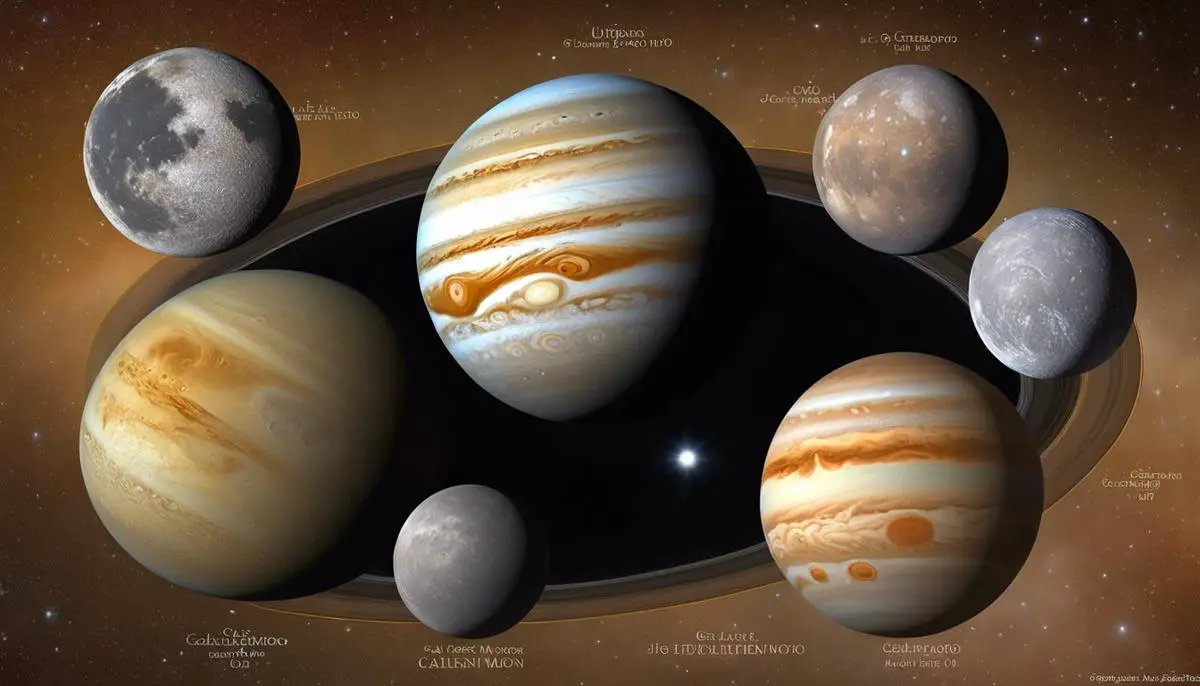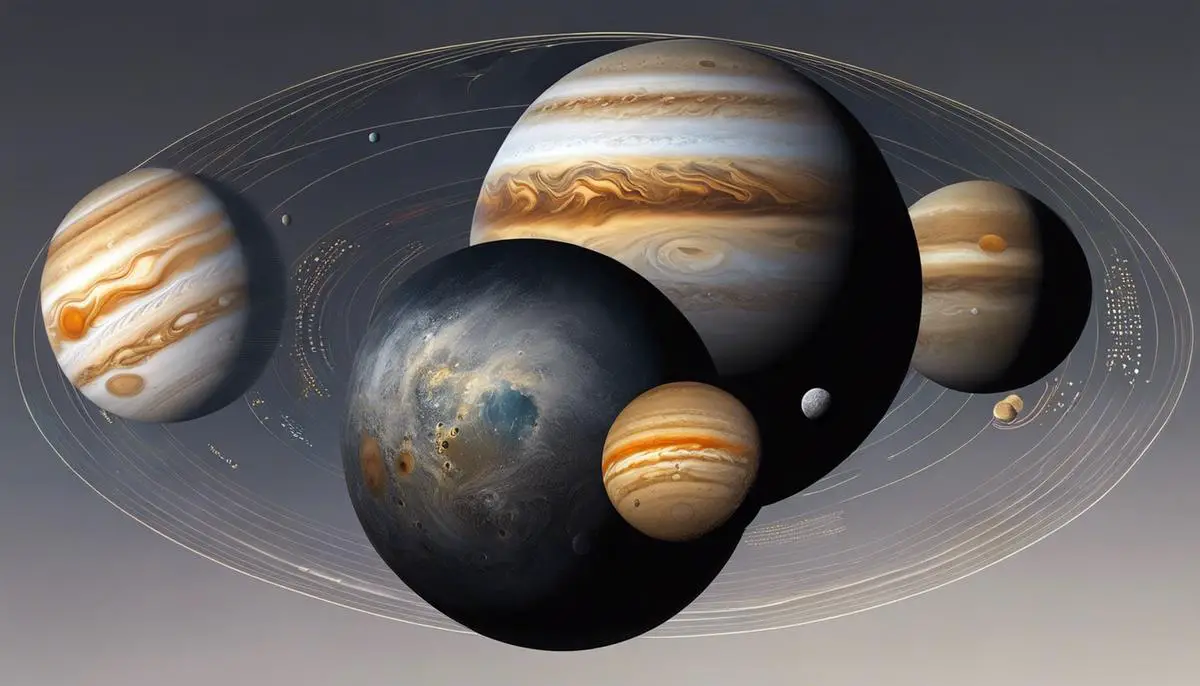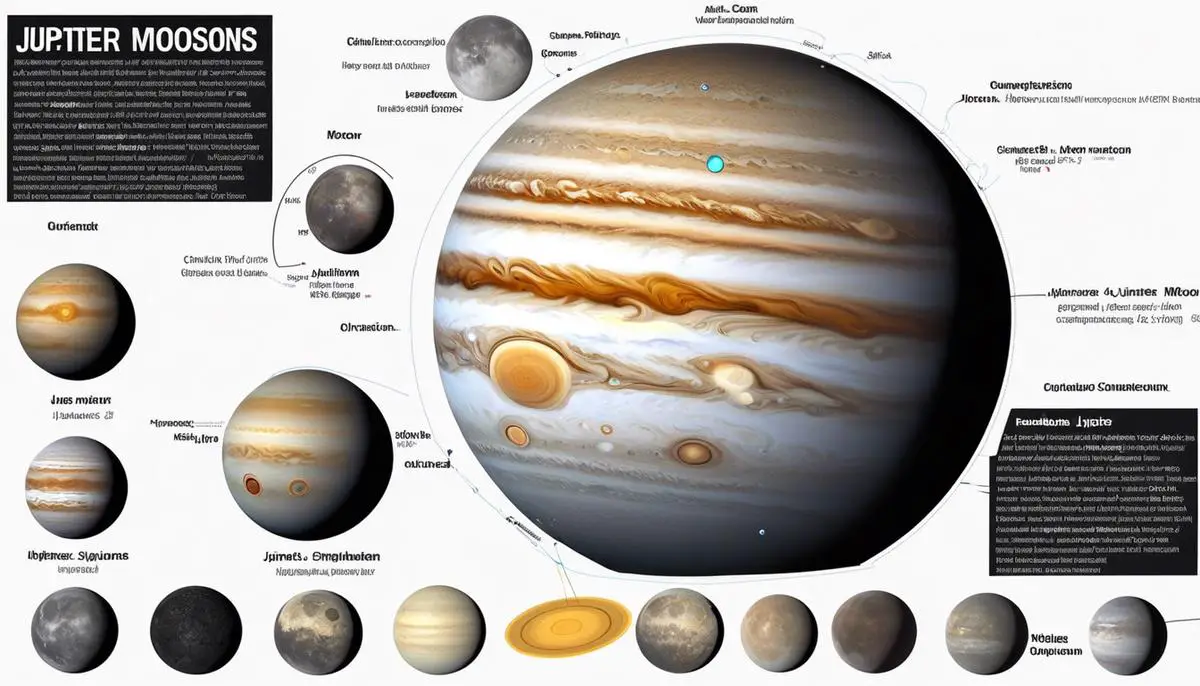Plunge into an enticing exploration of the moons of Jupiter, a comprehensive blend of astronomy and mythology. This in-depth exploration goes beyond surface-level knowledge, presenting an engaging clarity about the celestial bodies orbiting Jupiter, our solar system’s largest planet. Physical characteristics, unique orbits, and historical discoveries all come into play as we delve into the imposing landscape of these magnificent satellites. Yet the substance of the planets extends beyond the astronomy, intertwining with mythological narratives that bring out full-bodied, rich interpretations. Infused with characters predominantly from Greek and Roman folklore, the names of these moons hold fascinating tales worth unfolding.
Overview of Jupiter’s Moons
Foremost in the seemingly boundless expanse of our solar system, Jupiter, the most massive planet, effortlessly hosts a staggering array of 79 known moons — a celestial stage set for a deep exploration of planetary dynamics, astrochemistry and astrophysics. Understanding the key characteristics of Jupiter’s moons not only unravels the intensely captivating science behind them but also shines a light on the vast tapestry of the cosmos beyond.
The Gas Giant’s four largest moons — known as the Galilean moons, named after Galileo Galilei who discovered them in 1610 — Io, Europa, Ganymede, and Callisto dominate the Jovian system and are as diverse as they are remarkable.
Io, the innermost of the four Galilean moons, is a geological powerhouse, teeming with over 400 active volcanoes thanks to its intense gravitational interactions with Jupiter and its sister moons. These celestial tugs of war endow Io with a constant flow of internal heat, culminating in breathtaking celestial exhibitions of molten sulfur and silicate rock, catapulted miles into space. Subsequently, this delicate dance between the forces has painted the moon’s surface with intriguingly intricate patterns in shades of yellow, brown, white, and even red.
Moving slightly farther out is Europa, an ice-locked world enthralling scientists and researchers alike with the tantalizing possibility of basements of extraterrestrial life. Beneath its icy surface, a deeply ensconced, potentially habitable ocean of saltwater persists. The juggernaut of energy required to maintain sub-zero temperatures on its surface while simultaneously warming its ocean depths is again, thanking the gravitational interactions with its parent planet Jupiter.
The third Galilean moon, Ganymede, stands unrivaled in its size, as it secures the title of the largest moon in our solar system, outmatching even planet Mercury. Its crowning jewel, however, resides not in its size but in its magnetic field, making Ganymede the only moon in our solar system to possess one. This lunar marvel houses a magnetosphere within Jupiter’s magnetosphere, hinting at a convecting, or moving, molten core.
Finally, there lies Callisto, the outermost of the four Galilean moons. Devoid of strong tidal heating, it shelters the oldest, most heavily cratered surface in the solar system, serving as a celestial chronicle of cosmic collisions dating back billions of years.
In the orchestration of the universe, the intriguing variety and dynamism of Jupiter’s moons underscore a battleground of forces and hint at the marvels of celestial evolution over epochs. They remain an impressive testament to the diversity that galaxies can foster and a call to action for further study and exploration. As our understanding of these extraterrestrial lands deepens, we uncover more than just the mechanics of celestial bodies – we are, in essence, expanding the horizons of human knowledge and pushing the very boundaries of what we consider possible.

Mythological Names of Jupiter’s Moons
Delving Deeper Into Jupiter’s Moons’ Mythological Names
A contemplation of celestial bodies’ names often leads to inquiries of their earthly origins. Jupiter, known to many as the king of the planets in our solar system, boasts a retinue of major moons named after figures from Greek mythology. Their appellations resonate far beyond mere naming conventions, providing simplistic summaries for Jupiter’s ongoing celestial drama.
The mythological background of Jupiter’s four largest moons stems from the voluminous tales of Greek mythology. These moons, known as the Galilean moons, were inadvertently named after the lovers of Zeus, the Greek equivalent of the Roman god, Jupiter. Many scientists appreciate the poetic significance of these names as they each present a brief chronicle of the moon’s unique characteristics and occurrence.
Io, for instance, draws upon the myth of a beautiful nymph that caught the attention of Zeus. The myth outline parallels Io’s tumultuous relationship with Jupiter, manifested in the moon’s heightened geological activity, contributing key understanding in planetary tectonics and magnetism.
Europa, famously abducted by Zeus when he took the guise of a handsome bull, reflects the intrigue and mystery surrounding its potential subsurface ocean and possibility of extraterrestrial life. The icy surface is a testament to the allure and secret that Europa, the moon and the mythical character, holds.
The names Ganymede and Callisto further illustrate this connection. Ganymede, the handsomest of mortals, was carried off to become the cup-bearer for the gods, a fitting epitome for the largest moon in the solar system. The moniker speaks to its distinct magnetosphere and potential for further exploration.
Callisto, a nymph of Artemis turned into a bear and cast into the sky, aligns with the ‘bruised’ surface of the moon, scarred by numerous cosmic collisions. The craters encapsulate cosmic history, serving as a valuable physical archive that aids in comprehending the history of our universe.
As these moons were named, the astrophysical universe was infused with legends and tales from Greek mythology, creating a rich tapestry of celestial and earthly narratives intertwined. Witnessing these moons through a telescope not only unearths the awe-inspiring splendor of the cosmos but also presents a narrative intricately woven by myth and science. These mythological names serve as a compelling reminder that our perception and understanding of the cosmos are not mere scientific endeavors. They also encapsulate the profundity of human imagination and our ceaseless endeavor not just to explain the world around us, but also to make it intriguing and meaningful. This combination of myth and science provides a profound depth to the field of celestial study, benefiting the advancement of astronomical science and the endless pursuit of knowledge.

Interplay between Jupiter’s Moons and their Mythological Namesakes

It is through the harmonious union of science and mythology that we unearth and appreciate the intricate connotations of the moons of Jupiter. By drawing parallels between each celestial body’s physical and orbital characteristics and its corresponding mythological figure, a captivating new dimension is added to our understanding of these moons. This seamless blend of objective empirical observations and philosophical narratives brings the beauty of astronomical bodies within the context of amazing mythological stories. As we unravel the charming mysteries of the universe, it becomes evident that our celestial neighbours are more than just distant lights – they are the embodiment of compelling narratives that link our existence to the cosmos.
![]()
